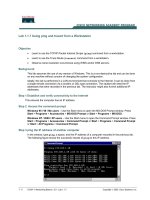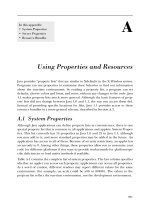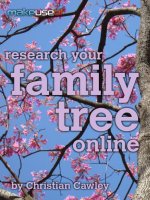Research Your Family Tree Online
Bạn đang xem bản rút gọn của tài liệu. Xem và tải ngay bản đầy đủ của tài liệu tại đây (4.8 MB, 104 trang )
Research Your
Family Tree Online
By Christian Cawley,
/>Edited by Justin Pot.
Cover photo by mauroguanandi on Flickr
This manual is the intellectual property of
MakeUseOf. It must only be published in its
original form. Using parts or republishing
altered parts of this guide is prohibited without
permission from MakeUseOf.com.
Think you’ve got what it takes to write a
manual for MakeUseOf.com? We’re always
willing to hear a pitch! Send your ideas to
; you might earn up
to $400.
Table Of Contents
1. Uncover Your Ancestors Using Your
Computer
2. Different Types of Family Tree Applications
3. Researching Your Family Tree Online
4. Researching Your Family Tree with
Ancestry
5. Using Online Research for Offline
Discoveries
6. Family History and Multimedia
7. Your Family History Is Waiting To Be
Discovered
Appendix
MakeUseOf
1. Uncover Your Ancestors
Using Your Computer
Your computer plays games, and with it you
can check email or browse the web. You
might develop presentations, run your
finances through a spreadsheet and even
contribute to a crowdsourced research
project. But did you know that your computer
can also tell you who you are, and where you
came from?
A growing trend in computer use is that of
researching a family tree, using online and
offline resources alongside a customised
database project to figuratively travel back in
time and meet your ancestors.
Various specialist software tools are available
to help you to map your family tree – so
called because of the way the members of
various generations of a family spread out in a
diagram – and there are websites available
that can help you out with everything from
census results to finding graves.
1.1 What Is a Family Tree?
A family tree is two things
Most commonly, it is a logical arrangement of
generations from now (probably starting with
you) and stepping back in history. As we are
all biologically the product of two parents who
are both a product of two more parents. This
progression through time results in the tree –
best demonstrated as a diagram – double
with each generation.
However, the family tree is also the intangible
connection that you feel to these people as
you uncover their birthdays, their life events,
and elements of their personality. Photos and
recordings can be added to the most modern
genealogy database software, along with
stories that you might find from friends,
relatives and even books and newspapers
clippings.
These details help to turn your ancestors into
real people, giving a stronger idea as to how
they lived. A genealogy project can bring the
past to life in ways that you might not have
realised.
1.2 Why Are You Researching?
With this in mind, it is worth considering just
why you are researching your family tree.
Who are you looking for? What are you
looking for?
Could you be trying to understand your family,
and the values that you and your siblings
have? Are you trying to establish a historical
trend, perhaps for working in a particular
industry or field?
For me, I was fascinated by the comparative
mystery that surrounded my maternal
ancestors, despite living around 20 miles from
where they were born, lived and died. I can
also tell you that my wife's own family tree
featured a mystery – just where did her great-
great-grandfather come from, and was this
farmer really related to a family of well-known
journalists?
Once you can understand why you are
researching, it can help you to focus your
efforts on the information you're looking for –
and who to research.
1.3 Genealogy Explained
The term genealogy is derived from the
Greek words for generation and knowledge.
It is essentially the collection of data and
information about families, enabling the
researcher to trace both lineage (who is
descended from who) and history (who
married who, worked where, achieved what,
etc.).
When you first begin researching your family
tree you might begin by taking notes from
older relatives before looking into historical
records and visiting places where your
ancestors lived. However, the Internet and
specialist software can give you a
considerable advantage, helping you to find
new facts, dates and material from the
comfort of your desktop PC, laptop or tablet.
1.4 How Computers Play a Part
Various software applications and websites
can play their part in helping you research,
collate and organize your family tree, enabling
you to build up a picture of who your
ancestors were, how and where they lived,
what they did for a living, and so on.
With census data perhaps the most commonly
accessed information available online for this
purpose, the Internet has become a major
aspect of genealogy research. Military
records, immigration records, newspaper
articles and probate documents are also vital
resources, and many of these are also
archived or indexed on the web, ready for you
to start digging up your family history.
As you build up your records, you'll need
somewhere to store the data. There are
various applications that are designed to help
you do this, basically databases with the
focused aim of providing visualisations and
reports that you can use to add the
information that you've found. One application,
Family Tree Maker, even integrates with the
Ancestry.com website, meaning that you don't
even need to manually add the data – the
application does it for you! These are just two
of the services we'll be looking at later in this
guide.
However you plan to conduct your research,
at some point you'll need a computer, and
maybe some office software if you plan on
keeping a diary or journal, or perhaps records
of the contacts you have made in the process
of your exploration.
1.5 Overview: Where Data Can Be Found
Beyond the web, there are other places
where you can find data. Libraries,
newspaper offices, graveyards, public record
offices, schools, churches, military bases and
local museums can all be vital resources as
you research your family tree.
Coupled with the online tools described
above, these places can provide data
concerning birth, death, marriage, debt,
baptism, conscription and perhaps even
photos, not to mention probate records
(wills), school records, details of employment
and much more.
As a result, while the immigration and census
records available online are important, these
offline sources are just as relevant.
1.6 Who Are You?
You can't research a family tree without first
knowing who you are. This can be anything
from appreciating family characteristics to
knowing the names of your immediate family,
specifically your parents and grandparents.
From there, you can then begin to work
backwards, researching census results and
birth records to trace your family further back.
As you find out more, you'll no doubt
recognise some barely familiar stories,
perhaps parallels with your own life and even
photographs that might highlight a physical
similarity with yourself.
One thing to keep in mind: not everyone is
ready to start researching their family tree.
Even with the vast resources available online,
this is a time consuming and often emotional
process, one that can – in many
circumstances – bring emotional wounds long
since forgotten to the surface
You should, therefore, be completely
prepared for the possibility of revelations.
More importantly, be ready to spend a lot of
time researching your family history, as it is a
fascinating subject that you can quickly get
lost in. In fact, it might even take over your
life!
2. Different Types of Family Tree
Applications
Various types of software exist for
researching and managing the research of
your family tree. These range from database
applications that present your collated
research in an attractive tree-based format to
utilities for converting data between
applications and websites and even mobile
apps.
Furthermore, there is free and premium
software that you can install. Premium
applications can be bought online and even
downloaded from the publishers' websites,
and often come with free trial versions
Free alternatives often offer many of the
same features, but whether you use a free or
premium application, you'll be able to add
photos and notes to your collection of names,
dates and locations.
All of the options listed below provide support
for GEDCOM, the data standard for
genealogy software. This basically means
that it should be easy for you to move your
data between software packages if you
change applications. GEDCOM data can also
be uploaded to the web and shared via email,
as you will see later in the guide.
2.1 Premium Software
Probably the most famous genealogy
database software on the market is Family
Tree Maker. Other apps include Legacy
Family Tree and MacFamilyTree, although
there are many others, which you'll find listed
in the Appendix.
2.1.1 Family Tree Maker
If you have attempted to start research into
your family tree in the past you may have
downloaded a trial copy of Family Tree Maker
or found it mounted to the front of a related
magazineOriginally released in 1989, the
application has had a number of owners over
the years; it is now published by
Ancestry.com, the main online database of
census and other genealogy records
worldwide.
Although there are some very good
alternatives, both paid and freeware, if you
are planning to research your family tree
using online resources, Family Tree Maker
has the advantage of being closely integrated
with Ancestry.com. See chapter 5 for more
details about this and using Family Tree
Maker as your genealogy research tool.
Family Tree Maker is available for as little as
£30 or as much as £80, depending on which
package you buy. More expensive releases
come with bulky guides and free subscriptions
to Ancestry.com. You can see why this is the
most popular option for many researchers! A
Mac version is also available: Family Tree
Maker for Mac 2. Full details can be found at
2.1.2 Legacy Family Tree
[Image Credit:
/>Dating back to 1997 and still going strong,
Legacy Family Tree is a freemium app,
meaning that although available free initially,
additional features are on offer that you must
pay to unlock. As such, it comes in two
editions, the free Standard version and the
Deluxe release, which starts at $29.95.
Like Family Tree Maker, Legacy Family Tree
is a family history database tool, and although
the Deluxe version offers many more
features, the basic tasks are available in both:
Adding family data.
Running reports and alternative views.
Keeping track of notes, research and
logging sources.
Adding pictures, sound and video.
Finding duplicates (a common problem
with any family tree research);
Creating a website from your family tree
data.
As you can see from the screenshot, Legacy
Family Tree looks very different to Family
Tree Maker, and the software certainly feels
different, with a focus more on personal
research rather than pulling in results from the
web.
Legacy Family Tree 7.5 is for Windows Vista,
7 and 8, although older versions are available
for previous Windows versions. Head to
/>to download your free copy.
2.1.3 MacFamilyTree
[Image Credit:
/>A Mac-only application, MacFamilyTree is
similar to Legacy Family Tree in its approach,
preferring database tools and multimedia
enhancements to your records to the built-in
web-based data import that Family Tree
Maker can achieve.
Offering views, reports and even an innovative
3D Virtual Tree, MacFamilyTree has been
going strong since 1998 and can handle
databases of 10,000 people without your
Mac's performance being affected.
Furthermore, data from this application can
be saved to Apple's iCloud service – ideal for
if you also choose to use the
MobileFamilyTree Pro app for iPhone and
iPad.
A free demo version of MacFamilyTree is
available and the full app can be purchased
for $49.99. More information can be found at
/>2.2 Free Software
Although Legacy Family Tree is available
initially as a free product, this isn't the only
free tool that you can use to aid you in your
research. Several free and open source
software alternatives are available, such as
Gramps and GenealogyJ.
2.2.1 Gramps
Available for Linux, BSD and Solaris as well
as Windows and Mac OS X, Gramps is the
ultimate cross-platform desktop genealogy
application, enabling full database editing and
the specifying of personal data, relationships
and geographical information.
Despite its open source status, Gramps is a
polished piece of software, offering a
selection of data analysis widgets (known as
"Gramplets"), detailed events for your
research subjects, repositories, notes and the
all-important inclusion of media such as
photos and videos. The app also supports
printing customised family tree charts.
Ideal for anyone not using Windows or Mac
OS X, find out more and download your free
copy at .
2.2.2 GenealogyJ



![Tài liệu [ Team LiB ] Configuring Your Safe Senders List The Safe Senders list is part of the Junk E-mail pdf](https://media.store123doc.com/images/document/14/nu/js/medium_jsx1390245650.jpg)





